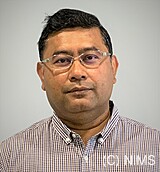
KEYNOTE SPEAKERS

Professor Manosh Paul
Email: Manosh.Paul@glasgow.ac.uk
University of Glasgow, UK
Speech Title: Roles of Bio-Hydrogen in Net-Zero Energy and Sustainability
Abstract:In this talk he will begin by providing a brief overview of the current challenges of energy decarbonisation and the potential roles of hydrogen and bioenergy-based carbon capture, utilization and storage (BECCUS) in the net-zero energy transition. He will then focus on the University of Glasgow’s research activities that are particularly relevant to these, highlighting (i) advanced thermochemical/gasification routes for the production of low/carbon-neutral bio-hydrogen (i.e. H2-enrich biosyngas) from biomass and waste, and (ii) combustion challenges of these fuels for end-use applications.
The presentation will also highlight research progress in the context of BECCUS, which has the potential to provide net-negative emission bio-hydrogen.

Professor Firoz Alam
Email: firoz.alam@rmit.edu.au
School of Engineering
RMIT University, AUSTRALIA
Speech Title: A Prospective New Energy Hydrogen: Challenges and Opportunities
Abstract: The increasing global population and socio-economic activities have led to a significant surge in energy demand, accompanied by severe environmental pollution and climate change issues such as global warming, frequent extreme weather events, and biodiversity losses. Furthermore, the reserves of fossil fuels are finite and rapidly depleting. Therefore, the finding of alternative zero-emission and/or low-carbon new energy (such as solar, wind, geothermal, and hydrogen energy) has become vital to developing cleaner, more efficient, and sustainable energy solutions. To achieve both the "carbon neutral" goals and worldwide sustainable energy development, the production of green hydrogen is crucial. Green hydrogen can efficiently balance energy supply and demand by converting excess renewable energy into hydrogen for storage and transportation, thereby increasing the overall stability and efficiency of the energy system, especially considering the intermittent and unpredictable nature of solar and wind renewable energy supplies. Thus, the main objectives of this work are to provide an overview of global renewable hydrogen energy development, challenges, opportunities, and a roadmap for a green hydrogen strategy for emerging and developing countries, including Bangladesh.

Professor Yingai Jin
Email: jinya@jlu.edu.cn
Jilin University, CHINA
Speech Title: The Application of Energy Storage Technologies in Integrated Energy Systems: Current Status, Challenges, and Future Prospects
Abstract: Integrated Energy Systems (IES) are becoming increasingly essential for achieving high energy efficiency and ensuring stable energy supply, especially with the growing share of renewable energy sources. Energy storage technologies play a pivotal role in these systems by balancing energy supply and demand, stabilizing grid operations, and enhancing the flexibility of energy use. This study provides an overview of the current applications of various energy storage technologies, including electrochemical, mechanical, thermal, and chemical storage, in IES. The advantages and limitations of each technology are discussed, along with their specific roles in IES implementation. Additionally, key challenges related to technology, cost, and policy that impede the widespread adoption of storage solutions are identified. Finally, future trends in energy storage development are explored, with a focus on technological advancements, cost reductions, and policy frameworks that could facilitate the large-scale integration of storage technologies into IES.




